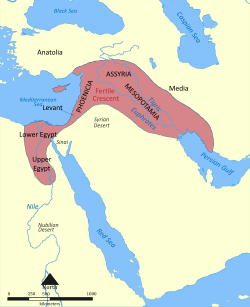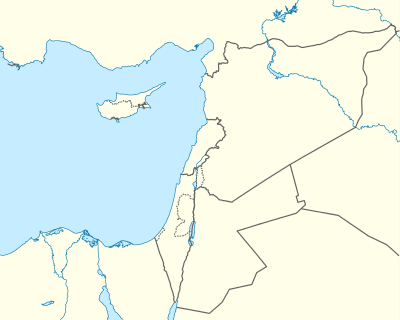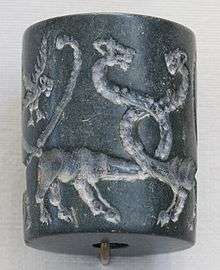Pre-Pottery Neolithic B
 | |
| Geographical range | Fertile Crescent |
|---|---|
| Period | Pre-Pottery Neolithic |
| Dates | c. 9600–c. 8000 BP |
| Type site | Jericho, Byblos |
| Preceded by | Pre-Pottery Neolithic A |
| Followed by | Halaf culture, Hassuna culture, Neolithic Greece, Khirokitia, Faiyum A culture |
Pre-Pottery Neolithic B (PPNB) is a Neolithic culture centered in upper Mesopotamia. It was typed by Kathleen Kenyon during her archaeological excavations at Jericho in the West Bank. Like the earlier PPNA people, the PPNB culture developed from the Mesolithic Natufian culture. However, it shows evidence of a northerly origin, possibly indicating an influx from the region of north eastern Anatolia.
Lifestyle

Cultural tendencies of this period differ from that of the earlier Pre-Pottery Neolithic A (PPNA) period in that people living during this period began to depend more heavily upon domesticated animals to supplement their earlier mixed agrarian and hunter-gatherer diet. In addition the flint tool kit of the period is new and quite disparate from that of the earlier period. One of its major elements is the naviform core. This is the first period in which architectural styles of the southern Levant became primarily rectilinear; earlier typical dwellings were circular, elliptical and occasionally even octagonal. Pyrotechnology was highly developed in this period. During this period, one of the main features of houses is evidenced by a thick layer of white clay plaster floors highly polished and made of lime produced from limestone.
It is believed that the use of clay plaster for floor and wall coverings during PPNB led to the discovery of pottery.[1] The earliest proto-pottery was White Ware vessels, made from lime and gray ash, built up around baskets before firing, for several centuries around 7000 BC at sites such as Tell Neba'a Faour (Beqaa Valley).[2] Sites from this period found in the Levant utilizing rectangular floor plans and plastered floor techniques were found at Ain Ghazal, Yiftahel (western Galilee), and Abu Hureyra (Upper Euphrates).[3] The period is dated to between ca. 10,700 and ca. 8,000 BP or 7000 - 6000 BCE.
Society
Danielle Stordeur's recent work at Tell Aswad, a large agricultural village between Mount Hermon and Damascus could not validate Henri de Contenson's earlier suggestion of a PPNA Aswadian culture. Instead, they found evidence of a fully established PPNB culture at 8700 BC at Aswad, pushing back the period's generally accepted start date by 1,200 years. Similar sites to Tell Aswad in the Damascus Basin of the same age were found at Tell Ramad and Tell Ghoraifé. How a PPNB culture could spring up in this location, practicing domesticated farming from 8700 BC has been the subject of speculation. Whether it created its own culture or imported traditions from the North East or Southern Levant has been considered an important question for a site that poses a problem for the scientific community.[4][5][6][7][8][9][10][11]
Extent
Work at the site of 'Ain Ghazal in Jordan has indicated a later Pre-Pottery Neolithic C period, which existed between 8,200 and 7,900 BP. Juris Zarins has proposed that a Circum Arabian Nomadic Pastoral Complex developed in the period from the climatic crisis of 6200 BCE, partly as a result of an increasing emphasis in PPNB cultures upon animal domesticates, and a fusion with Harifian hunter gatherers in Southern Palestine, with affiliate connections with the cultures of Fayyum and the Eastern Desert of Egypt. Cultures practicing this lifestyle spread down the Red Sea shoreline and moved east from Syria into southern Iraq.[12]
The culture disappeared during the 8.2 kiloyear event, a term that climatologists have adopted for a sudden decrease in global temperatures that occurred approximately 8,200 years before the present, or c. 6200 BCE, and which lasted for the next two to four centuries. In the following Munhatta and Yarmukian post-pottery Neolithic cultures that succeeded it, rapid cultural development continues, although PPNB culture continued in the Amuq valley, where it influenced the later development of the Ghassulian culture.
Genetics
Pre-Pottery Neolithic B fossils that were analysed for ancient DNA were found to carry the Y-DNA (paternal) haplogroups E1b1b (2/7; ~29%), CT (2/7; ~29%), E(xE2,E1a,E1b1a1a1c2c3b1,E1b1b1b1a1,E1b1b1b2b) (1/7; ~14%), T(xT1a1,T1a2a) (1/7; ~14%), and H2 (1/7; ~14%). The CT clade was also observed in a Pre-Pottery Neolithic C specimen (1/1; 100%).[13] Maternally, the rare basal haplogroup N* has been found among skeletal remains belonging to the Pre-Pottery Neolithic B,[14] as have the mtDNA clades L3[15] and K.[16] DNA analysis has also confirmed ancestral ties between the Pre-Pottery Neolithic culture bearers and the makers of the Epipaleolithic Iberomaurusian culture of North Africa,[17] the Mesolithic Natufian culture of the Levant, the Savanna Pastoral Neolithic culture of East Africa,[18] the Late Neolithic Bell-Beaker culture of Morocco,[19] and the Ancient Egyptian culture of the Nile Valley,[20] with fossils associated with these early cultures all sharing a common genomic component.[19]
See also
References
- ↑ Amihai Mazar, Archaeology of the Land of the Bible:10,000 - 586 BCE, Doubleday: New York, 1992, 45.
- ↑ Chris Scarre. Timeline of the Ancient World, pg. 77.
- ↑ Amihai Mazar, Archaeology of the Land of the Bible:10,000 - 586 BCE, Doubleday: New York, 1992, 45.
- ↑ Helmer D. ; Gourichon L., Premières données sur les modalités de subsistance dans les niveaux récents de Tell Aswad (Damascène, Syrie) – fouilles 2001-2005., 2008.
- ↑ Vila, E.; Gourichon, L.; Buitenhuis, H.; et al., eds. (2008). "49". Archaeozoology of the Southwest Asia and Adjacent Areas VIII. Actes du 8e colloque de l'ASWA. 1. Lyon: Travaux de la Maison de l'Orient. pp. 119–151.
- ↑ Helmer D. et Gourichon L., Premières données sur les modalités de subsistances dans les niveaux récents (PPNB moyen à Néolithique à Poterie) de Tell Aswad en Damascène (Syrie), Fouilles 2001-2005, in Vila E. et Gourichon L. (eds), ASWA Lyon June 2006., 2007.
- ↑ Stordeur D. Tell Aswad. Résultats préliminaires des campagnes 2001 et 2002. Neo Lithics 1/03, 7-15, 2003.
- ↑ Stordeur D. Des crânes surmodelés à Tell Aswad de Damascène. (PPNB - Syrie). Paléorient, CNRS Editions, 29/2, 109-116., 2003.
- ↑ Stordeur D. ; Jammous B. ; Khawam R. ; Morero E. L'aire funéraire de Tell Aswad (PPNB). In HUOT J.-L. et STORDEUR D. (Eds) Hommage à H. de Contenson. Syria, n° spécial, 83, 39-62., 2006.
- ↑ Stordeur D., Khawam R. Les crânes surmodelés de Tell Aswad (PPNB, Syrie). Premier regard sur l’ensemble, premières réflexions. Syria, 84, 5-32., 2007.
- ↑ Stordeur D., Khawam R. Une place pour les morts dans les maisons de Tell Aswad (Syrie). (Horizon PPNB ancien et PPNB moyen). Workshop Houses for the living and a place for the dead, Hommage à J. Cauvin. Madrid, 5ICAANE., 2008.
- ↑ Zarins, Juris (1992) "Pastoral Nomadism in Arabia: Ethnoarchaeology and the Archaeological Record," in O. Bar-Yosef and A. Khazanov, eds. "Pastoralism in the Levant"
- ↑ Lazaridis, Iosif; et al. (17 June 2016). "The genetic structure of the world's first farmers". bioRxiv 059311. -- Table S6.1 - Y-chromosome haplogroups
- ↑ Fernández, Eva; et al. (2014). "Ancient DNA analysis of 8000 BC near eastern farmers supports an early neolithic pioneer maritime colonization of Mainland Europe through Cyprus and the Aegean Islands". PLoS Genetics. 10 (6): e1004401. doi:10.1371/journal.pgen.1004401. PMC 4046922. PMID 24901650.
- ↑ Fernández, Eva; et al. (2014). "Ancient DNA analysis of 8000 BC near eastern farmers supports an early neolithic pioneer maritime colonization of Mainland Europe through Cyprus and the Aegean Islands". PLoS Genetics. 10 (6): e1004401. doi:10.1371/journal.pgen.1004401. PMC 4046922. PMID 24901650.
- ↑ Fernández Domínguez, Eva. "Polimorfismos de DNA mitocondrial en poblaciones antiguas de la cuenca mediterránea". Universitat de Barcelona. Retrieved 19 October 2017.
- ↑ van de Loosdrecht et al. (2018-03-15). "Pleistocene North African genomes link Near Eastern and sub-Saharan African human populations". Science. American Association for the Advancement of Science (AAAS): eaar8380. doi:10.1126/science.aar8380. ISSN 0036-8075.
- ↑ Skoglund; et al. (September 21, 2017). "Reconstructing Prehistoric African Population Structure". Cell. 171: 59–71.
- 1 2 Fregel; et al. (2018). "Ancient genomes from North Africa evidence prehistoric migrations to the Maghreb from both the Levant and Europe" (PDF). bioRxiv 191569.
- ↑ Schuenemann, Verena J.; et al. (2017). "Ancient Egyptian mummy genomes suggest an increase of Sub-Saharan African ancestry in post-Roman periods". Nature Communications. 8: 15694. doi:10.1038/ncomms15694. PMC 5459999. PMID 28556824.
